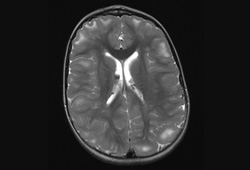Summary
განსაზღვრება
ანამნეზი და გასინჯვა
ძირითადი დიაგნოსტიკური ფაქტორები
- family history
- epilepsy
- cardiac rhabdomyoma (single or multiple)
- renal angiomyolipomas
- lymphangioleiomyomatosis of the lung
- cerebral subependymal calcified nodules
- multiple cortical tubers and/or radial migration lines
- giant cell astrocytoma
- facial angiofibromas
- cephalic plaque(s)
- nontraumatic ungual or periungual fibromas
- hypomelanotic macules
- shagreen patch(es) (connective tissue nevus)
- retinal nodular hamartoma(s)
- polycystic kidney disease
სხვა დიაგნოსტიკური ფაქტორები
- numerous dental enamel pits and intraoral fibromas
- autism
- cognitive impairment
- behavioral problems
- multiple hamartomatous colonic polyps
რისკფაქტორები
- genetic predisposition
დიაგნოსტიკური კვლევები
გასათვალისწინებელი კვლევები
- genetic testing
- brain MRI
- neurodevelopmental assessment
- electroencephalogram (EEG)
- ECG
- echocardiography
- abdominal MRI
- glomerular filtration rate (GFR)
- blood pressure
- high-resolution chest CT
- pulmonary function tests and 6-minute walk test
- skeletal x-ray
- colonoscopy
- renal biopsy
მკურნალობის ალგორითმი
renal cell carcinoma (suspected or confirmed)
intracranial aneurysm
neurologic
skin lesions
renal
cardiovascular
pulmonary
cognitive and behavioral
კონტრიბუტორები
ავტორები
Francis J. DiMario Jr, MD, MA, FAAP
Professor of Pediatrics and Neurology
University of Connecticut School of Medicine
Associate Chair for Academic Affairs and Faculty Development
Department of Pediatrics
Academic Chief Emeritus
Division of Pediatric Neurology
Connecticut Children's Medical Center
Hartford
CT
გაფრთხილება:
FJD is an author of a number of references cited in this topic.
რეცენზენტები
Robert Robinson, MBBS, MA, MRCP, PhD
Consultant Paediatric Neurologist
Great Ormond Street Hospital
London
UK
გაფრთხილება:
RR declares that he has no competing interests.
David Neal Franz, MD
Professor of Pediatrics and Neurology
Director
Tuberous Sclerosis Clinic
University of Cincinnati College of Medicine
Cincinnati Children's Hospital Medical Center
Cincinnati
OH
გაფრთხილება:
DNF declares that he has no competing interests.
რეცენზენტების განცხადებები
BMJ Best Practice-ის თემების განახლება სხვადასხვა პერიოდულობით ხდება მტკიცებულებებისა და რეკომენდაციების განვითარების შესაბამისად. ქვემოთ ჩამოთვლილმა რეცენზენტებმა თემის არსებობის მანძილზე კონტენტს ერთხელ მაინც გადახედეს.
გაფრთხილება
რეცენზენტების აფილიაციები და გაფრთხილებები მოცემულია გადახედვის მომენტისთვის.
წყაროები
ძირითადი სტატიები
Northrup H, Aronow ME, Bebin EM, et al. Updated international tuberous sclerosis complex diagnostic criteria and surveillance and management recommendations. Pediatr Neurol. 2021 Oct;123:50-66.სრული ტექსტი აბსტრაქტი
Caban C, Khan N, Hasbani DM, et al. Genetics of tuberous sclerosis complex: implications for clinical practice. Appl Clin Genet. 2016 Dec 21;10:1-8.სრული ტექსტი აბსტრაქტი
Amin S, Kingswood JC, Bolton PF, et al. The UK guidelines for management and surveillance of tuberous sclerosis complex. QJM. 2019 Mar 1;112(3):171-82.სრული ტექსტი აბსტრაქტი
de Vries PJ, Whittemore VH, Leclezio L, et al. Tuberous sclerosis associated neuropsychiatric disorders (TAND) and the TAND Checklist. Pediatr Neurol. 2015 Jan;52(1):25-35.სრული ტექსტი აბსტრაქტი
Li M, Zhou Y, Chen C, et al. Efficacy and safety of mTOR inhibitors (rapamycin and its analogues) for tuberous sclerosis complex: a meta-analysis. Orphanet J Rare Dis. 2019 Feb 13;14(1):39.სრული ტექსტი აბსტრაქტი
გამოყენებული სტატიები
ამ თემაში მოხსენიებული წყაროების სრული სია ხელმისაწვდომია მომხმარებლებისთვის, რომლებსაც აქვთ წვდომა BMJ Best Practice-ის ყველა ნაწილზე.

დიფერენციული დიაგნოზები
- Periventricular nodular heterotopia (PNH)
- Multiple endocrine neoplasia (MEN-1)
- Birt-Hogg-Dubé syndrome
მეტი დიფერენციული დიაგნოზებიგაიდლაინები
- Updated international tuberous sclerosis complex diagnostic criteria and surveillance and management recommendations
- Updated international tuberous sclerosis complex diagnostic criteria and surveillance and management recommendations
მეტი გაიდლაინებიშედით სისტემაში ან გამოიწერეთ BMJ Best Practice
ამ მასალის გამოყენება ექვემდებარება ჩვენს განცხადებას